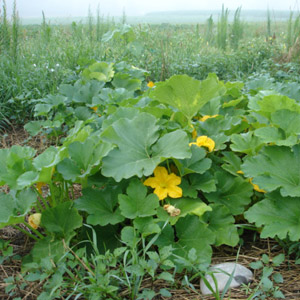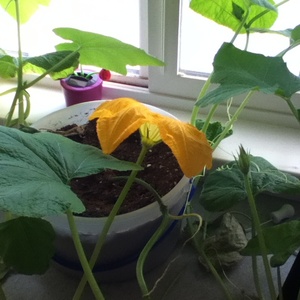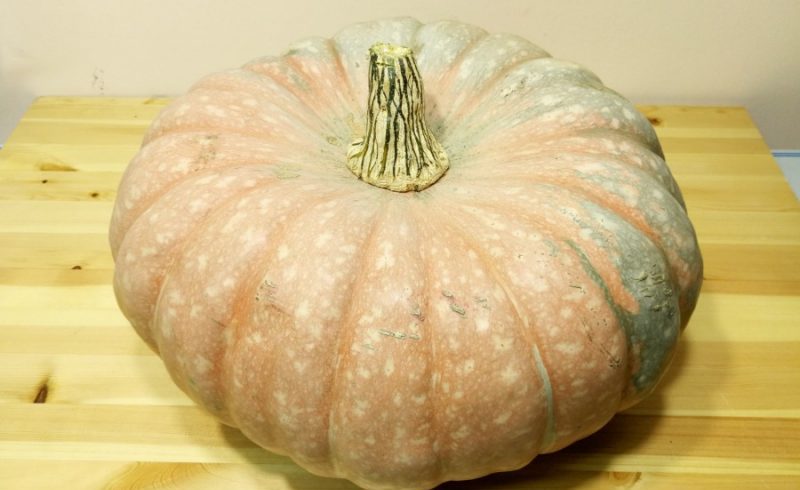An ideal hybrid for cooking delicious dishes - pumpkin "Butter pyshka" and the peculiarities of its cultivation
Pumpkin is one of the most unpretentious fruit crops to care for. It can grow in open ground even in the harsh climate of the central and northern regions of our country. It is grown all over the world for sweet and main dishes. This herb contains a large amount of nutrients with a low calorie content, it is good for health and is indispensable in dietary nutrition.
In our country, people are especially fond of the sweet varieties of this representative of melons. They are distinguished by their versatility. Pumpkin Sweet donut is especially popular. She has great taste and unusual appearance. What are the advantages and disadvantages of this hybrid - read on.
The content of the article
Common scripture for pumpkin
Pumpkin Butter donut is a hybrid of the first generation. It was bred by crossing two varieties.
Note! The seeds of the fruits of Butter Puff are not used for planting, since plants with parental characteristics grow from them.
The hybrid is not included in the state register. It is produced by the Russian Garden Company.
Distinctive features of Buttery crumpet
Butter crumpet has fruits with an original crust color - green with a whitish bloom. With them, pumpkin beds look decorative.
The hybrid was named for its rich sweet taste. The pumpkin has a rich aroma with notes of baked goods.
There is a lot of pulp in fruits, but few seeds. They are juicy, therefore they are suitable for fresh consumption, they fall apart during prolonged heat treatment.
Pumpkin is considered a dietary product that does not cause allergies. It contains many useful substances, including beta-carotene, B vitamins, and fiber. The seeds have an anthelmintic effect.
Like many hybrids, Butter Donut is immune to most diseases inherent in melons. But its resistance to temperature extremes is low.
Main characteristics
Description Butter puff will delight both beginners and gardeners who grow crops for sale. She has good yields and excellent taste.
| Parameters | Indicators |
| Ground part | Powerful climbing plant. The peduncles are thick and long. Stems are round, without pronounced ribbing. The leaves are large, round, rich green. Powerful roots go deep underground. Thin roots grow several meters over the surface. |
| Fruit | Medium size. The weight of one pumpkin reaches 7-8 kg. The crust is not very thick. Outside it has a dark green color with a whitish (almost bluish) bloom. Inside, the berries are dark orange. The shape is round, with a depression characteristic of this culture at the base and ribbing throughout the entire area. The taste is sweet, with a pumpkin aroma. There are notes of fresh baked goods. There is a lot of juicy pulp. There are few seeds. The concentration of sugars reaches 10%. |
| Ripening terms | Late ripening. The fruits ripen 135 days after the first shoots appear. |
| Transportability | High. Pumpkins are stored for up to 1 year. |
| Yield | High. Up to 3 fruits weighing about 7 kg are harvested from one plant. |
| Immunity | It is immune to most diseases of melons and gourds. |
How to grow
Pumpkin is a crop that requires minimal maintenance.It is grown in dachas and vegetable gardens. Even a novice gardener can handle its cultivation.
Fortified mature plants are able to withstand heat. At temperatures below +10 degrees, this representative of the melons stops its growth.
Pumpkin loves fertile, loose soil. On poor soil, it is also capable of growing, but in this case the fruits will be small and not very tasty. If the soil is poor, the best solution would be to plant a plant near a manure heap. In this case, it will be provided with essential nutrients throughout the season.
Melons are light-requiring. They are planted in the lightest part of the garden.
It is important to observe crop rotation. The pumpkin is not planted in areas where other melons, cucumbers and zucchini previously grew. Beds after nightshades, legumes and root crops are suitable.
The plot intended for pumpkins is prepared in the fall: the remains of plants are removed and applied to 1 sq. m 7 kg of manure or humus. After that, the soil is dug up, mixing it with top dressing, and the acidity of the soil is checked. Dry lime or ash will help reduce the indicators.
A few days before planting the pumpkin, the beds are leveled with a rake, clearing the weeds.
Landing
In the southern regions, pumpkin is grown in both seedling and non-seedling methods. For the central and northern lane, only the first option is suitable.
Before planting, seeds are prepared to accelerate germination, protect plants from diseases and increase their resistance to negative external factors:
- Large dense seeds are suitable for sowing. Empty, sluggish and darkened are thrown away.
- The planting material is soaked in water at a temperature of 40-50 ° C for 3 hours. To prevent the liquid from cooling during this time, the containers are placed on the battery.
- After soaking, the seeds are wrapped in moist warm gauze. The tissue with the planting material is placed in a container and covered with a film. Warm liquid is constantly added. The seeds will be ready to plant when they open.
- The opened seed material is kept in the refrigerator for 3 days. This is necessary to increase its cold resistance.
It is interesting! Old pumpkin seeds have a higher germination rate than fresh ones. Some gardeners practice artificial aging of the planting material, which involves keeping the seeds in the oven.
Seedlings
Seeds are sown in the second decade of April. A month later, when the threat of return frosts passes, they are planted in open ground.
Pumpkin seedlings are grown on southern windowsills. Room temperature is considered ideal for germination.
It is not recommended to sow the seeds of this culture in a common box, since the pumpkin does not tolerate picking well. Gardeners advise using peat pots, from which the plants are not removed when planting in a permanent place. The container volume must be at least 300 ml.
Seedling soil is sold in stores. Universal mixes are suitable. To prepare the soil yourself, sand and peat are mixed in equal proportions.
Both purchased and homemade soil mixture are disinfected - heated in the oven or watered with a dark pink solution of potassium permanganate.
Containers for disinfection are soaked for half an hour in a solution of dark pink potassium permanganate.
A drainage layer (sawdust, broken ceramics, brick, expanded clay or fine gravel) is poured into the bottom of the pots. 2 seeds are sown in one container, deepening by 2 cm.
When growing pumpkin, observe the temperature regime. This will prevent pulling plants:
- before seed germination - 26–30 ° С;
- the first 7 days after germination - 20-23 ° С;
- next week - 15-18 ° С;
- the rest of the time the plants are grown at room temperature.
As it dries, the soil is watered with warm, settled water, trying not to get on the ground part of the plants. If the watering is excessive, the plants will start to rot.
For the entire growing period, seedlings are fed only 1 time - 2 weeks after sowing. Use "Nitrofoska" or mullein.Fertilizers are applied only after watering.
Seedlings are transplanted to a permanent place after the appearance of three true leaves. When buying plants, it is important to keep their internodes short.
If both seeds germinate in the container, pinch the weaker plant. It is important not to pull out the stem, as this may damage the roots of the second pumpkin.
Planting scheme: 100 × 100 cm.Before transplanting, water is poured into each hole and manure is placed.
When growing pumpkin in a plastic container, the seedlings are removed along with a lump of earth and placed in a hole, forming the roots towards the center. When using peat pots, the container is not removed, but split.
Seeds
Planting seeds directly into open ground is possible only in the southern regions. When the soil reaches a temperature of 13–15 ° C at a depth of 15 cm, planting material is sown. This takes place in the second half of May.
For sowing seeds, use the same scheme as for planting seedlings (1 × 1 m). The width of the depressions varies between 20–35 cm. On the same bed, holes of different depths (6–10 cm) are dug to ensure seed germination.
Half a glass of humus or mullein is poured into the bottom of each hole. Two seeds are placed at different ends of each depression. A layer of earth is covered on top. Use 1 liter of water per hole.
Care
Although pumpkin is considered an unpretentious plant, it still needs regular care. To get a rich harvest, follow the basic rules:
- Water the pumpkin 1-2 times a week. At least 3 liters of water at room temperature are used per plant. During the flowering period, the amount of watering is increased. Water should not fall on the ground part of the plant, otherwise the likelihood of burns on the leaves increases. If the liquid gets on the flowers, the pollen will stick together and the fruit will not set.

- After precipitation and watering, the soil is loosened. This procedure is needed to restore root air exchange.
- In the process of loosening, the beds are cleared of weeds. This is done before they have grown, otherwise removing the mature weeds will damage the pumpkin's root system.
- After 3 true leaves appear on the plants, the weaker pinch... The growth of pumpkin lashes is limited after the sixth leaf. No more than three are left on one whip ovaries.
- Mullein, Nitrofoska and ash are used as fertilizers. The first time feeding is applied after the appearance of five leaves, then every two weeks.
- It is recommended to tie the pumpkin whips (although this is not required). To do this, they install trellises or let them run along the threads tied to the fence or roof of the house.
Features of cultivation and possible difficulties
When growing pumpkin, gardeners often complain that the leaves turn yellow. This happens for several reasons:
- Lack of nutrients. On poor soils, pumpkin requires more feeding. In this case, manure is used as fertilizer.
- Rotting roots. This is due to root rot (fungal disease) or irrigation irregularities. In this case, hilling will save the plant.
- Abundance of fruits. If you do not remove excess ovaries, the plant will not be able to develop normally.
- End of the growing season. When all the fruits are ripe, the leaves begin to turn yellow and fall off. This is a natural process that should not be hindered.
Growing tips from experienced gardeners
Even a novice summer resident can handle pumpkin cultivation. To get the maximum yield and tasty fruits while facing a minimum of problems, there are a few secrets to know:
- It is better to press the pumpkin whips to the ground in several places. This will facilitate the emergence of new roots. Thanks to this, the plant can survive even if the main root is damaged.
- Place wooden substrates under the pumpkins. If this is not done, the fruit can rot.
- Pumpkins hanging on lashes directed to the fence or house are secured by tying them with nets.
- During the period of fruit ripening, watering is stopped.This will make the flesh sweeter.
Diseases and pests
Butter crumpet is resistant to diseases of melons and gourds. However, this does not exclude the possibility of infection. To avoid infection of plants, the rules of prevention are observed:
- All the tool that interacts with the pumpkin beds is processed. This applies to containers, soil and seeds.
- Plants are treated with a solution made from a grated bar of soap and a bucket of water, or a decoction of wormwood. This will scare away pests. Also use a decoction of wormwood, prepared from a quarter of a bucket of grass, filled with boiling water to the edges of the container.
- Watering and stepson the pumpkin early in the morning or at sunset.
Harvesting and application of the crop
The pumpkin is harvested at the end of September. The fruits are removed together with the stalk. In this form, they will be stored for more than 1 year.
The use of a hybrid is universal. Butter donuts pumpkins are suitable for making juices, desserts and main courses.
Advantages and disadvantages of a hybrid
Advantages of Butter Puff:
- rich sweet taste;
- an abundance of pulp;
- disease resistance;
- high productivity;
- universality of application.
The disadvantage of Butter Puff is hybridity. The seeds from its fruit are not suitable for planting.
Varieties with similar names

There are pumpkin varieties similar in name to Butter Puff. But they have other characteristics:
- Sweet crumpet - hard-bore acorn-type butternut squash. It looks decorative. The fruits have pronounced ribbing. Outside white, with dark green spots and stripes; inside light yellow. The pulp is sweet, tender, with a nutty flavor. The weight of one pumpkin is 1-2 kg.
- Rosy crumpet - round slightly ribbed pumpkin. When ripe, it takes on a pink-orange color. The weight of one fruit reaches 9 kg. The pulp is sweet, there are many seeds.
Farmers reviews
Reviews of gardeners about the pumpkin Butter crumpet are mostly positive.
Irina, Moscow: «I have been growing butter for the third year. I like the unusual color of its fruits. They are greenish-white like in the picture. The pulp is sweet and juicy. Does not change taste when frozen. Three plants are enough to provide pumpkin for us and our grandchildren for the whole year. "
Gleb, Krasnodar: “Growing Butter Donuts for Sale. Buyers like it, so do I. The fruits are sweet and aromatic. They reach a mass of 8 kg. I feed only mullein. This is enough to get an excellent harvest. "
Read also:
The melon pumpkin variety, adored by gardeners for its sweet taste.
Popular among farmers pumpkin "Winter Sweet" with a pleasant taste.
Conclusion
Pumpkin Butter donut is a hybrid that even a beginner can grow. The plant is not afraid of melons and gourds diseases and costs minimal maintenance. The yield indicators are high.
Butter donut will decorate not only any dish, but also the garden. Its green fruits with a whitish bloom look unusual and decorative, and the taste is superior to many orange-fruited varieties.